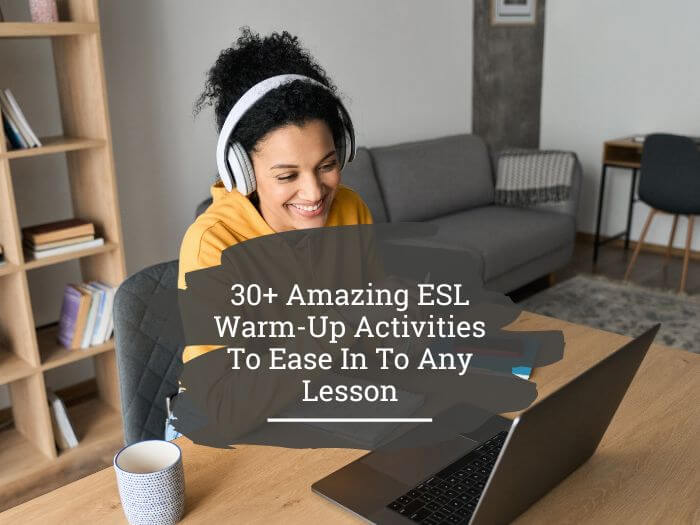When you know how to teach English online, you might be keen to jump straight into your latest ESL lesson. Woah there! You learners might not be! Settling into a lesson and getting warmed up is key.
In this post, you'll discover over 30 ESL warm up activities that will help your students ease into your lessons.
Some of these ESL warm up activities are best suited to in-person group classes. But many of them can be adapted for online ESL lessons, whether in groups or 1:1.
Time to warm up!
Pro Tip
If you want to become a qualified online language teacher and earn a living from home, I recommend checking out CeOLT (Certificate of Online Language Teaching).
1. Make Music Together

Nothing sets the mood like music. So have some music playing as the students come into class.
You can use this music as a way to get them talking – have they heard it before? Do they like it? What kind of music do they like?
This warm-up activity can also be done in an online class too!
2. You Can Quote Me On That
Write a quote of the day on the whiteboard and discuss it together. By the end of a term together, you and your students will have compiled a list of lovely quotes.
3. Memorise This
This is an ESL warm up activity to try in an in-person class. But you could adapt it for online ESL classes by screen sharing images or a list of words. Check out this post on teaching tools for online lessons for more on how to use the screen share.
Put some small objects on a tray such as a pencil, a rubber, a coin etc. Aim for around 25 to 30. Let the students look at the objects for two minutes and then cover them or remove the tray.
Students need to write down as many objects as they can possibly remember. They can do this individually or in teams. If you can’t find enough objects, you could write a list of words on the board.
4. Put It In Order
Get the learners to organise themselves in a line by date of birth, with people born early in the year on the left and those born later in the year on the right. This will naturally generate questions and discussion.
Vary the task by getting them to put themselves in alphabetical order according to their first names or by how far away they live. Get creative!

5. Dictation Game
Pick five to fifteen sentences or words from a previous lesson and dictate them. The learners need to write them down with correct spelling.
If you have a group class you can put learners in teams so they can discuss and agree on what to write.
At the end, go over the words or sentences dictated and give points for completely correct answers.
6. Miming Hotel Guest
Write down a list of both probable and improbable sentences that a guest would say to a hotel receptionist such as “what time is check out?” or “I threw the TV out of the window”.
Give a sentence to a student who then mimes it so that the rest of class can guess what it is. You can vary the types of situation and sentence.
7. Hangman
I’m sure you’ve played this gruesome word guessing game before! And you can also use it in the ESL classroom.
Choose a word you want the student(s) to revise, perhaps because it came up in a previous class or because it’s connected to this one.
Draw the gallows on the board and then draw a dotted line below it to represent the number of letters in the word you’ve chosen.
Learners then have to suggest possible letters. For each incorrect one, you draw another piece of the gallows.
8. Back To the Board

Ask the students to create two teams. One team then sends a member to the front of the class, to sit with their back to the board.
Write a word you’d like the students to review on the board. The student’s team then has to help them guess it, without saying the word.
Once the learner at the front manages to guess the first word, write another one on the board. You can change teams after two minutes of this.
9. Connect The List
The idea of this guessing game is to read out a list of ten connected words and have the learners guess the connection. So you might read out “bucket, spade, towel, beach” for “beach holiday” or “summer holiday”.
You can make this as easy or as hard as you like depending on the connections and words you choose.
To limit the number of guesses and make it more competitive, give students 10 points which they lose one by one for any incorrect answers.
Once they’ve grasped the concept, they can play the game in pairs or teams. As this game is materials-light, you can play it in both in-person and online classes.
10. What’s In The Box?
This one is as simple as it sounds – put an object in a box and get students to ask questions until they figure out what it is. You can give them the object in the box as a prize – don’t make it a family heirloom or anything!
A variation of this activity would be to let them touch the object, without looking at it. You could then use this as an opportunity to teach/revise words to do with texture like “hard”, “soft”, “slimy”, “wet” etc.
11. Idioms Alike
Write an idiom on the board and explain the meaning to the students. Then ask them to give the equivalent idiom in their language and translate it into English.
For instance, if you teach them the meaning of “The grass is greener on the other side” then, depending on the composition of the class, you might discover the Turkish equivalent which is “A neighbour’s chicken looks like a goose to his neighbour”.
This warmer is easily adaptable to 1:1 classes or online classes too! Have fun learning idioms in different languages!

12. I Went Into Town…
This warmer is another vocabulary revision game and is especially good for reinforcing countable vs uncountable nouns.
Choose a topic such as “clothes”. The first student says, “I went into town and bought a t-shirt”. The next one adds another item to the list and so on. “I went into town and bought a t-shirt and a pair of jeans”.
To make it more challenging, you can ask the students to name the items in alphabetical order.
So if the topic was “food” the first student could say “I went into town and bought an avocado”. And the next would add “I went into town and bought an avocado and some beans”.
13. Word Scramble
This one will work in online or in-person classes. All you need to do is write some words that your students have recently met on the board. But scramble the letters so the students have to rearrange them.
After that you could try making sentences. Or the learners could create their own word scrambles to bamboozle the others.
14. Chasing Your Tail
Choose a topic such as sports. A student will say a sports-related word such as “gymnastics”. The next student must say a word starting with the final letter of the previous word, in this case ‘s’. So “gymnastics” => “swimming” => “golf” => “football” => …?
A student is out if they can’t come up with a word or their word is off-topic or starts with an incorrect letter. Each word can only be used once. When someone gets stuck, restart the game with a new word: “trainers” => “swimsuit” => “t-shirt” => …?
15. Two Truths And A Lie

Ok, this one is also on my ESL icebreakers list. But it’s such a classic that you don’t only need to use it in first lessons to get to know each other.
Write three sentences about yourself on the board – two are true and one is a lie. Students have to figure out the false sentence.
They can also do this activity in pairs or in front of the rest of the class.
16. 20 Questions
You may have played this classic guessing game before in another context. Pick a person, place, thing or animal. The students are allowed 20 yes/no questions to guess who or what you are. They can also play this game in small groups.
17. Vocab Bag
This one is pretty simple. As new words come up in class, note them down on post-it notes or slips of paper and put them in a bag or box. When you start a lesson or when you have a few spare minutes before the end of class, ask a student to pull a word out of the bag.
You now have several options. You can ask them to translate the word (if you’re in a monolingual class) or to define it or give a synonym or perhaps the word’s opposite. You could also ask them to put it in a sentence.
You could even ask them to give clues about the word so the others can guess, which brings me nicely to the next ESL warmer on this list.
18. Taboo

You may have played this word-guessing game outside of class and your learners are probably familiar with it too in their language.
The idea of Taboo is to work in small teams. One person in the team is given a card with a word on it. They have to get their others in the group to guess the word on the card.
To make it more challenging, there are a list of “taboo” words on the card that they’re not allowed to say. And there’s a time limit.
A “censor” from the opposing team sits with the player, ensuring that they don’t say one of the taboo words. The team members can make as many guesses as they like, with no deductions for wrong guesses.
Even if you don’t have the board game, you can either make your own cards based on vocabulary you want your students to revise or search online for printable versions for ESL classes.
19. Quick Crossword
The students find some words that they’ve learned in the last couple of lessons and suggest two that have at least one letter in common.
Write them on the board and have them overlap, like you would in a crossword puzzle. You could do this in-person or online, on an interactive whiteboard.
Ask the students to continue suggesting words, so that together you can make the grid as big as possible.
20. Call My Bluff

Have you heard of “Call My Bluff’? It was a BBC radio show that later became a TV show. Contestants had to guess the correct definitions of obscure words among one true definition and two bluffs.
You don’t have to use obscure vocabulary with your learners, but you can ask them to form teams and then find the dictionary definition of a set of words you give them. The teams also need to create two fake definitions.
The teams then come together and have to figure out which definitions are true and which are false!!
21. False Facts
Another warmer that involves spotting the bluff!
Dictate some sentences that each contain a piece of false information. Learners need to write them out and underline the part they think is fake. Afterwards, you can show them the sentences and ask them to point out the factual error.
The facts could be to do with general knowledge or with something that came up in class recently.
22. Odd One Out
Read aloud four sentences and ask learners to spot which one is the odd one out. You could also do this with single words but sentences enable your students to hear words in context.
Here’s an example:
- If I had asked, I would have got help.
- If I had seen her, I would have spoken to her.
- If I had studied, I wouldn’t have failed the test
- If had seen him, I would have asked him.
23. Contraction Dictation

Read out a list of sentences containing contractions that the students need to write down. Afterwards, they need to write the sentences with the full form on the board or interactive white board or Google Document.
Here are some example sentences you can use:
- She’s busy
- I’ll check with him
- He’s walking the dog
- There’s your sister
24. Longest Word From The Longest Word
I have one of my primary school teachers to thank for this. She printed out the longest word in English and put it on the wall. It’s this monster: pneumonoultramicroscopicsilicovolcanoconiosis.
Whenever we finished an activity early, she would ask us to make as many words as possible from this gigantic word.
You can kick off your lessons by asking the students to make the longest word they can, using this one as a source word or another.
You can choose to make it competitive or not. Using a timer to give them two minutes to make the longest word possible, would also be a good idea. Speaking of which…
25. Countdown
Have you seen the famous Channel 4 game show Countdown before?
In the TV programme, contestants choose 9 random vowels and consonants from two stacks of face-down letter tiles. They then have 30 seconds to make the longest word possible from the letters and can only use each letter once.
The letter stacks in the gameshow are weighted according to frequency, a bit like in Scrabble. To make your life easier, you can either put an anagram of a word you’ve learned recently on the board, or use the letters in a bag from a game of Scrabble to draw letters randomly.

26. Jeopardy
Another game show favourite, this time using the US quiz show Jeopardy. In this game show, contestants are given answers and then have to guess the question based on the answer.
This warmer is a great way to get students to practise question formation, an area of English many find difficult.
You can make them as easy or as difficult as you like according to the level of your students. You can also include grammar structures you’ve recently studied in the questions.
Here are some examples:
- He’s from India (Where is he from?)
- It’s 9am (What time is it?)
- I love swimming and rugby (What are your favourite sports)?

27. Pictionary
This is another of these ESL warm up activities based on a fun party game. Give a student a word or concept that you’ve recently learned. They then have 60 seconds to draw it on the board and the other students have to guess the word.
In large groups, you can split the students into teams and do this activity with paper and pen rather than on the board.
This could also work in an online class with an interactive whiteboard but would be a bit more challenging!
28. Charades
Speaking of fun party games, why not use charades as a ESL warmer? Give a student a word or concept you’ve recently learned and ask them to mime it so that the others can guess what it is.
29. Give Me A Clue
This is a guessing game where you first give the learners a broad clue and then narrow it down, making it more obvious.
The students can take a guess after each clue.
Here’s an example:
- Clue 1: You use it to get around
- The students might guess “car”
- Clue 2: it has two wheels
- The students might say “motorbike”
- Clue 3: You don’t need a driving licence to use it
- The students might say “bicycle”
- Clue 4: You don’t need to pedal to make it move
- The answer: an e-scooter

30. The Price Is Write
Yet another of these ESL warm up activities that’s a game show adaptation, this time of “The Price Is Right”. And it will work easily (if not better) in online lessons. Use this warmer when you want to revise prices with learners.
Show students some images of articles from catalogues or online shopping sites without the prices. These could be images of furniture, electronics, clothes or shoes etc. Make sure the price is not visible or that only you can see it (you could write it on the back of the images).
Learners need to work in small groups to come up with a suitable price. Whichever team is closest to the actual price “wins”.
31. Proverbs Please
Write a proverb on the board and have students try to guess the meaning. They may have a similar one in their language that you could talk about.
You can use famous proverbs such as:
- The early bird catches the worm
- It’s no use crying over spilled milk
The Best ESL Warm Up Activities

So there you have it – over 30 ESL warm up activities to kick off your lessons in the best possible conditions.
You can also use many of these ESL warm up activities when you have a few spare minutes at the end of class. You can also use them as transition activities, to re-energise the students before changing focus.
As many of them are based on games, they will work in ESL classes with kids too. But even adult ESL learners appreciate having a bit of fun to transition out of their day and into their lesson.

Olly Richards
Creator of the StoryLearning® Method
Olly Richards is a renowned polyglot and language learning expert with over 15 years of experience teaching millions through his innovative StoryLearning® method. He is the creator of StoryLearning, one of the world's largest language learning blogs with 500,000+ monthly readers.
Olly has authored 30+ language learning books and courses, including the bestselling "Short Stories" series published by Teach Yourself.
When not developing new teaching methods, Richards practices what he preaches—he speaks 8 languages fluently and continues learning new ones through his own methodology.










































